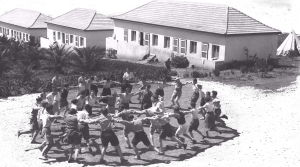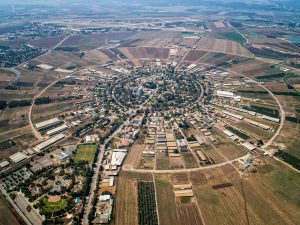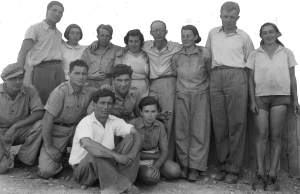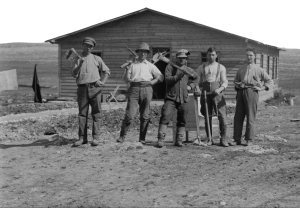The Kibbutz: A Detailed Exploration of Israel's Communal Settlements
Some people consider communities to be a pure utopia. In their opinion, it’s impossible to manage a large group of persons without government participation. But kibbutzim in Israel disprove this idea.
What Is a Kibbutz?

It is a unique phenomenon of Israeli culture, dating back over 100 years. Speaking about caboots, it’s important to give a definition to the word “moshav” (an Israeli agrarian community as well). But this movement gives more freedom in life organization to the inhabitants.
Definition and Historical Roots
So, what is the definition of kibbutz? It is a type of public community, centered around the values of member equality and cooperation in different spheres of life and historically devoted to agricultural labor. Team spirit, social equity and self-dedication to the commune are typical features of it.
The name of the first settlement was Degania. It was founded in 1909 in the vicinity of the Kinneret. The future kibbutz lands were acquired by the Jewish National Fund. Young trailbreakers arrived from the Eastern part of Europe. They were dreaming of cultivating the native land. Besides, there was one more great idea to embody – to create a unique type of community, able to put into reality the principle, saying “from each according to his ability, to each according to his needs”.
an Israeli citizenship specialist
The life pattern in kaputs was distressing enough. The settlement inhabitants had to deal with hard physical labor, poor soil, lack of farming knowledge and shortage of funds, water and food. Being quite strong, self-reliant and perfectly motivated the pioneers achieved success. They developed a great commune, producing a significant impact on forming and supporting the future state.
Inspired with the success of Degania other groups of Jews began to found kibbutzes, mostly near the Sea of Galilee and in the Jezreel Valley. In 1948 the state of Israel was born, its independence being declared officially. It was a kibbutz community which influenced greatly on both agrarian development and political and strategic spheres in the process of state formation. Moreover, the communes were fulfilling the role of defenders, situated mostly along the local boundaries.
The kibbutz movement was thriving much on the both economic and social sides during the 1960s and 1970s. The peak was reached by 1990.
Due to a succeeding economical crisis some of kibbutzes occurred to be bankrupt, and former members moved to Israeli cities looking for a chance of better life. In the beginning of the 21st century a new birth of the movement is observed, a kibbutz becoming a privatized unit.
The process of kibutz developing
The Unique Lifestyle of a Kibbutz

Daily Life and Communal Operations
Modern life of a kibbutz is sure to be different from the pioneers’ one. At the beginning members had neither personal choices nor individual or family budget. Every life question was discussed during communal assembly. Everybody had meals in a public dining hall. Everything was shared among the community.
Now it is still a democracy as a type of social governance. There is a general assembly for formulating the rules, electing officers, authorizing the budget and approving new members. It makes all important kibbutz life decisions. Besides, it functions as a forum for people to express their thoughts and ideas.
Family life also changed a lot. The kibbutz pioneers consider a family to be an unnecessary phenomenon. They put babies into special children’s houses where they were passing the time together with their age-mates, being looked after by qualified babysitters. Children visited their parents regularly but lived apart. Since the 1970s the situation has undergone a few changes. Now parents are caring for the kids themselves, even getting special kubbitz preferences when spending time with them as much as possible.
They also take part in age-mate group discussions and solving common problems. When being at high school, a person is to work for a kibbutz economic sphere one full day a week. When kibbutzim just came into existence, women tried to prove their competence by doing male work in the production sector and agriculture. They spent little time with kids and relatives.
Nowadays the situation has changed a bit. Women still may choose any working field inside the cabootz but, as a rule, they prefer being involved in spheres of less hard labor such as education, baby caring, medicine and all that.
Economic Aspects: Work and Financial Structure
People in a kabootz worked mostly in an agrarian sphere, cultivating the land. Since the 1920s some industry has been added. In course of time it has included the following branches:
In general kibbutzim manufacture quite a wide set of things, varying from apparel to irrigation systems, but these fields have only few workers engaged. Today agriculture gives only about 15 per cent of a kabutz income. The bulk of it is formed with industrial segments. In some areas communes even group their resources, forming new regional productions. For example, gin houses and poultry-packing factories. Besides, they render services in a computer sphere, marketing and what not.
Due to this, many guest houses, comfortable hotels, exotic animal farms, museums and other entertaining objects have appeared on the territory. They are usually visited both by Jewish inhabitants and foreign visitors as well. The majority of kaputz members are working within the commune, while some of them may be employed in regional companies. Besides, the group of people may perform their duties inside the kibbutz movement throughout the state.
The Israeli cities growing, some kibbutzes happen to become the suburbs of them. It gives the latter a possibility of providing urban population with public services, for example, catering, retailing and kids summer camping.
First workers had to give all the earnings in a communal pool. And this sum was shared among all the kabutz members. As time passed customs became more optional. Now everybody should donate only a certain amount of his or her income, spending the rest of it on individual needs. In spite of the idea of self-sufficient communal labor recently kibbutz members have to engage outside help for working on plants, factories, tourism sector and other stuff. By 2000 the number of hired workers had reached 60 per cent.
Kibbutzim in Israel: The Transformation Over the Years
A modern kibbutz consists of three generations of inhabitants. The first one is pioneers, grandparents now. They were strongly motivated, sticking to a distinct communal ideology. They were able to create a unique lifestyle. Their kids were born within the kubbutz. They continued developing the settlement, stabilizing its social and economic spheres. The third generation, contemporaries, is living now in a quite prosperous world, trying to unite Jewish traditions and modern technological spirit.
Modern Kibbutzes: Changes and Adaptations
There is some kind of a fear that Israeli kibbutzim adjustment to the modern world will lead to the loss of traditions and communal principles. But if caboots members continue keeping the democratic aura and the atmosphere of voluntarism they will be able to adopt thoroughly their orthodox way of living to the circumstances around.
Young Israeli citizens are still establishing caboots, using a bit of a new model of communal living. The settlements are situated in the urban area. Members of such kibbutzim are living together, sharing meals, celebrations, talking sessions and other similar things. The key point of these kaboots is that people keep their assets from pooling. Despite this fact, their aim is to unite all persons in the vicinity and improve the surroundings.
The Role of Kibbutzim in Israeli Society & Economy
Kibbutzim have been playing a great role in Israeli Society and economy. The movement formed a special cabuts lifestyle, joining people, motivating them and creating a specific ideological platform. Thanks to this fact, after the State of Israel establishing kibbutzim were able to provide its stability and comfortable development. They supported immigration, agronomy and defense spheres of life. They also helped on a political field, fulfilling national tasks.
Tours over the settlements, lectures on kibbutz life usually attract students and volunteers, making them stay in the commune and apply for membership.
Living in a Kibbutz: Costs, Processes, and Experiences
If one wants to live in a kebutz, he or she should learn and keep some general rules. Some kibbutzim venerate traditions very thoroughly; the others let the guests live a bit more freely. Anyway, you should know key points, so as not to get confused.
- Everybody should take part in commune works and activities.
- All the life issues are resolved together.
- The elderly are always supported by able-to-work persons.
- Before the legal age Jewish children are provided with everything by the kaboots.
- Every kaputz member should strictly abide communal discipline.
It must be added that some settlements put their own local rules before the state of Israel ones.
How to Join a Kibbutz
The first step of joining a kebutz is visiting Israeli settlements in the role of a volunteer or a special program participant. For example, Masa Israel Journey offers two variants of achieving a purpose:
| Kibbutz Ulpan | A five-month program, including learning Hebrew in authentical conditions. A person may choose a jewish kaputz to his liking (the place, where it is located, the lifestyle, the members are leading and other details). |
| International Dance Journey Program | A five-month dancing program, so-called “Dance Journey”. The age of participants is from 18 to 35. |
The kibbutz volunteering program is offered for persons from 18 to 35. The participants usually help the natives with simple jobs, such as gardening, cooking food, helping with animals, and fulfilling simple assignments in the factories. They usually share a room with other volunteers, use a communal dining-hall and work for about 8,5 hours per a day, having two days off every week.
The procedure of signing up to volunteering is quite easy:
- apply for the program
- make a plan of your trip
- assign the kibbutz and go there
If you want to join a Kibbutz, you have to live 3 years on the territory of the settlement, then present the necessary documents to the secretary. Just after it a communal assembly will decide if a person is appropriate or not. The answer being positive, you become a full-fledged member of the community, able to work together with the natives and use a common fund.
The Financial Aspect: Costs of Living
If you choose kibbutzim volunteering, you are to pay a proceeding fee of 40 USD and an assignment fee (medical insurance, a volunteer visa and a registration fee) of 1300 NIS to KPC (kibbutz program center). Besides, you are to have a deposit of 100 USD for increasing the period of living there, 300 USD for expenses. Every 3-monthes renewal of the visa will cost about 200 NIS.
The Cultural Impact of Kibbutzim
The cultural impact of Israeli kibbutz on society is quite significant. Caboots influenced much on keeping cultural traditions and joining people. There were a lot of Jewish festivals and national holidays. Every communal celebration was held according to Jewish customs. It touched upon not only social but individual events as well. Songs, dances and the arts stretched back to biblical times, associating with great Israeli patience and stamina.
Nowadays the idea of cultural development is also realized in establishing museums, devoted to archaeological, historical, artistic spheres. A great number of foreigners are interested in learning the Jewish traditions and customs, in studying the Hebrew and in possible moving to Israel. The kibbutzim make it possible by helping with cultural adaptation.
When the kibbutz movement was born, at the head of the whole affair there was a great motivation and a significant idea of absolute cooperation. In the course of time the ideology was going grey, letting the youngsters live due to the rules of world globalization. But in spite of this process, modern society continues keeping to the traditional communal principles. It testifies to a great basis, created by the first pioneers of Degania.
Kibbutzim Beyond Israel: Global Presence and Influence
There were a number of social communities on the territory of Europe and America in the 19th and 20th centuries, trying to organize a similar way of life as the kaputz did. But the Jewish communes appeared to be the most successful.
Kibbutz-style Communities in the USA and Other Countries
In Germany there was a specific settlement, named the “Kibbutz Buchenwald”. It was born in 1945 on the territory of the same name, where a Nazi concentration camp had been situated before. A group of surviving men formed an agricultural community. The aim of this foundation was to prepare Jews for emigration to their native land.
One more agricultural settlement was located in France. The kibbutz was named Makhar, joining Jewish inhabitants not only from German and France, but from Poland, Hungary and Russia as well. Even Americans lived and worked there. The whole number of members varies from 500 to 800. So, kibbutzim occurred to be popular not only on the native land but all over the world as well. They unite Jewish people, giving them home, work and some kind of stability in the hard times. In general, the kibbutz phenomenon is quite interesting and motivating. In course of time it underwent many changes. It became less strict and ideological, adapting to the whole world situation. However, it has kept safe the main idea of communal living and equality of persons. The movement has been supporting the state of Israel from the earliest ages in many spheres, being always interested in its development and prosperity.
an Israeli citizenship specialist




